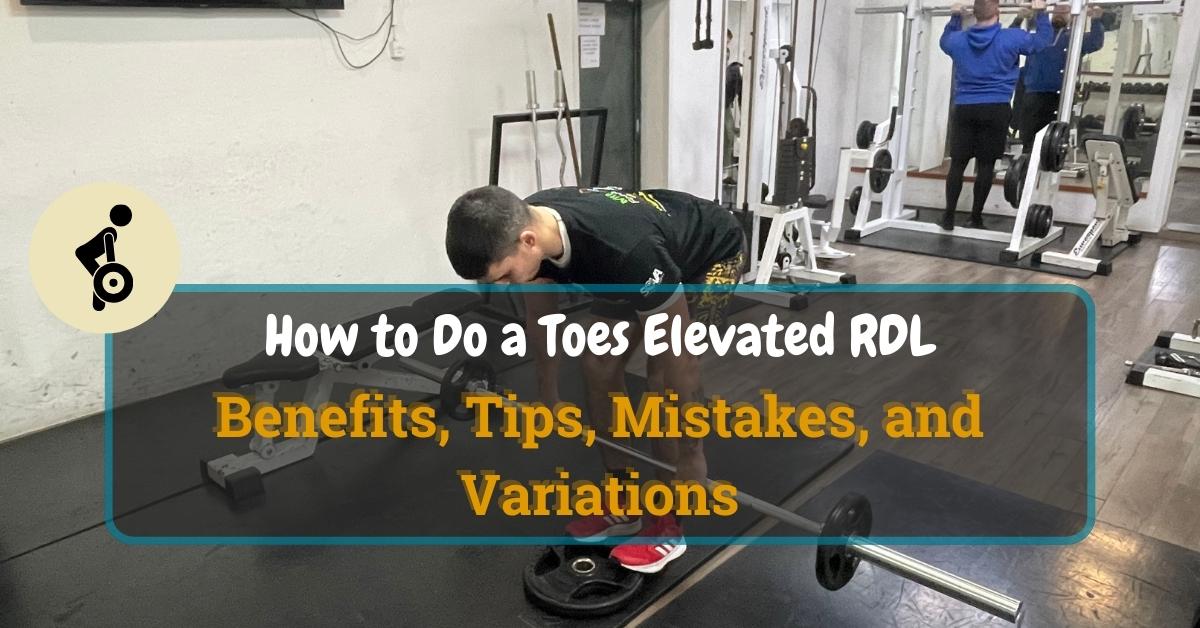As a Faculty of Sport and Physical Education student, I had a chance to analyze biomechanics behind the toes elevated RDL. What I found out is that the toes elevated Romanian deadlift is particularly effective in targeting the hamstrings, glutes, and lower back.
Table of Contents
ToggleIt is also more effective than the regular Romanian deadlift variation because you get a better starting stretch at your hamstrings. Also, toes elevated RDLs ensure your knees stay fixed because this variation limits their range of motion.
This is simply because the starting position requires more dorsiflexion at your ankles, which prevents further knee flexion.
After thorough research, analysis, and testing this exercise in the gym environment, I decided to create a simple guide.
Below, you can find clear instructions to perform toes elevated Romanian deadlifts, programming, muscles worked, benefits, tips, mistakes, alternatives, variations, and much more.
Start Building Your Dream Body Today
Ready to elevate your fitness game without falling into the trap of dull, repetitive routines that just don’t deliver? Imagine sculpting your ideal physique and boosting your health, all while still enjoying life’s pleasures, like those irresistible weekend getaways and your aunt’s legendary cheesecake. With our online fitness and nutrition coaching service, you don’t have to compromise. Dive into a personalized fitness journey that blends perfectly with your lifestyle, not against it. Book your completely free discovery consultation today, and take the first step towards a transformation that doesn’t require giving up the joys of life.

“I was skeptical about online fitness coaching, but Functional Body Savage completely changed my perspective. Vanja and Radomir’s personalized approach and attention to detail have helped me achieve goals I never thought possible. I’m stronger, more confident, and grateful for their guidance.”
Emily Thompson, San Francisco, CA
Learn More About Our Online Coaching ServiceQuick Summary
- To perform the toes elevated Romanian deadlift (RDL) properly and maximize performance, start by selecting an appropriate weight plate and barbell, assume a hip-width stance with toes elevated, maintain a neutral spine, and execute the lift with controlled movements focusing on the hamstrings, glutes, and lower back.
- This guide provides detailed instructions, programming advice, and variations for the toes elevated RDL, emphasizing proper form, controlled movements, and balanced lower body workouts.
- A study involving 408 participants found that posterior chain resistance training, similar to toes elevated RDLs, significantly reduces pain (SMD = -0.61) and disability (SMD = -0.53) and increases muscle strength (SMD = 0.67) over 12-16 weeks.
- Drawing from a wealth of practical applications, it’s evident that incorporating toes elevated RDLs into a fitness routine can lead to improved balance, increased hamstring flexibility, and enhanced posterior chain strength.
How to Do a Toes Elevated RDL
Here is how to do a toes elevated RDL properly to avoid injuries and maximize your performance.
Step One — Bring the Weight Plate and a Barbell
Start by selecting an appropriate weight plate and a barbell. The weight plate will be used to elevate your toes, and the barbell is for the lift itself.
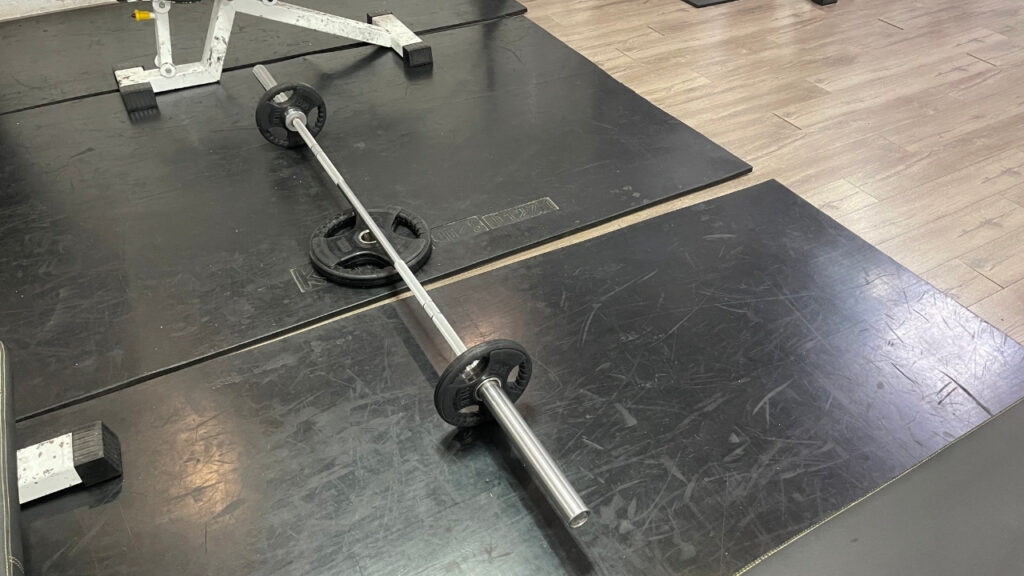
Pro Tip: Choose a weight plate that is stable and not too high to maintain balance. The height should be enough to elevate your toes slightly without causing discomfort.
Step Two — Assume the Starting Position
Stand with your feet hip-width apart, toes on the weight plate, and heels on the ground. Grip the barbell with hands just wider than shoulder-width apart.
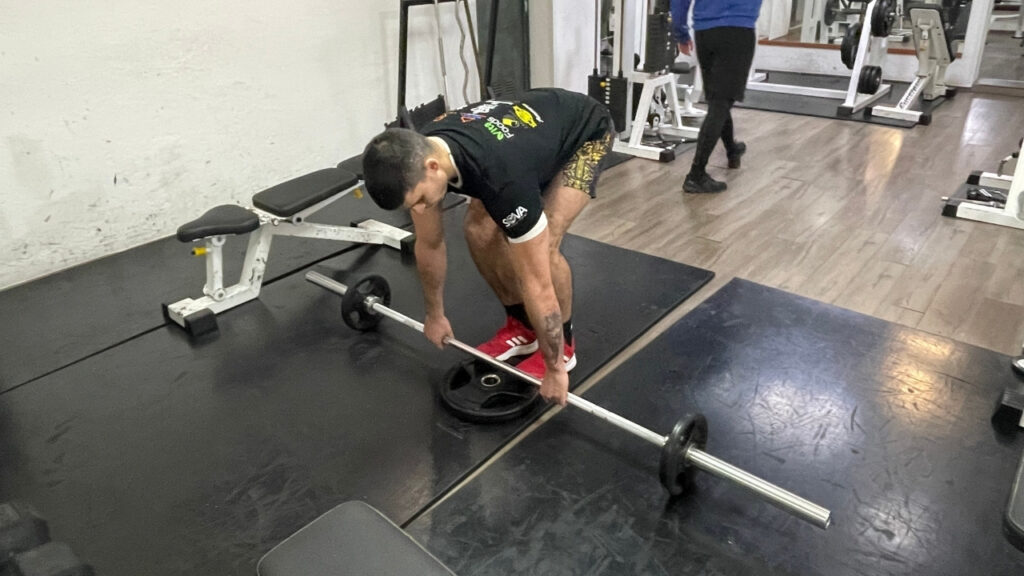
Pro Tip: Keep your spine neutral and shoulders back to engage your core. This position helps in stabilizing your body throughout the exercise.
Step Three — Lift the Barbell off the Floor
Lift the barbell, keeping it close to your body. Straighten your legs and hips to stand up fully, holding the barbell at thigh level.
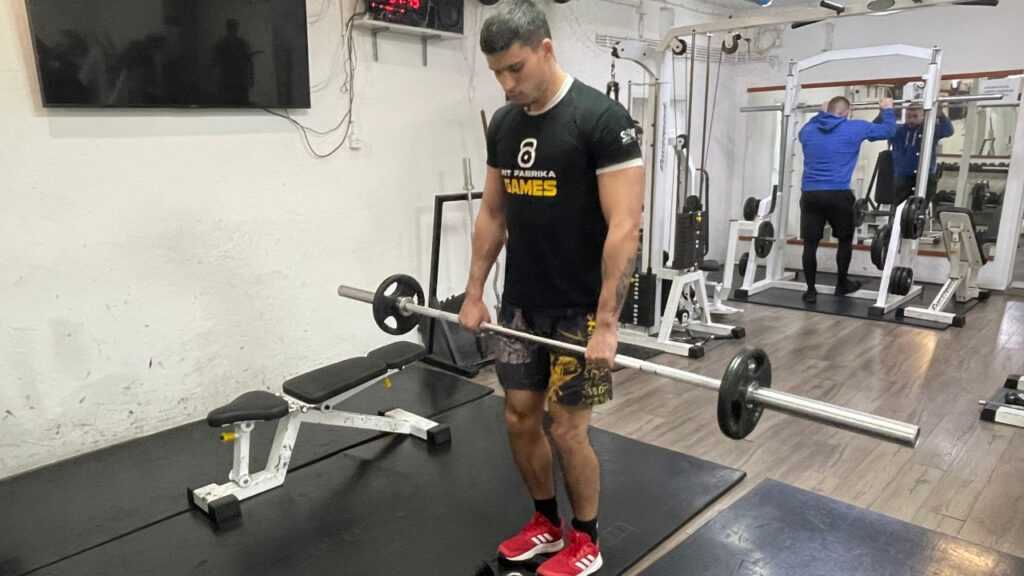
Pro Tip: Focus on driving through your heels to lift the weight, which activates your posterior chain muscles more effectively.
Step Four — Perform the Descending Phase
Slightly flex your knees and keep them fixed in that position during the entire movement. Hinge at your hips to lower the barbell down towards the ground. Go as low as your flexibility allows without rounding your back.
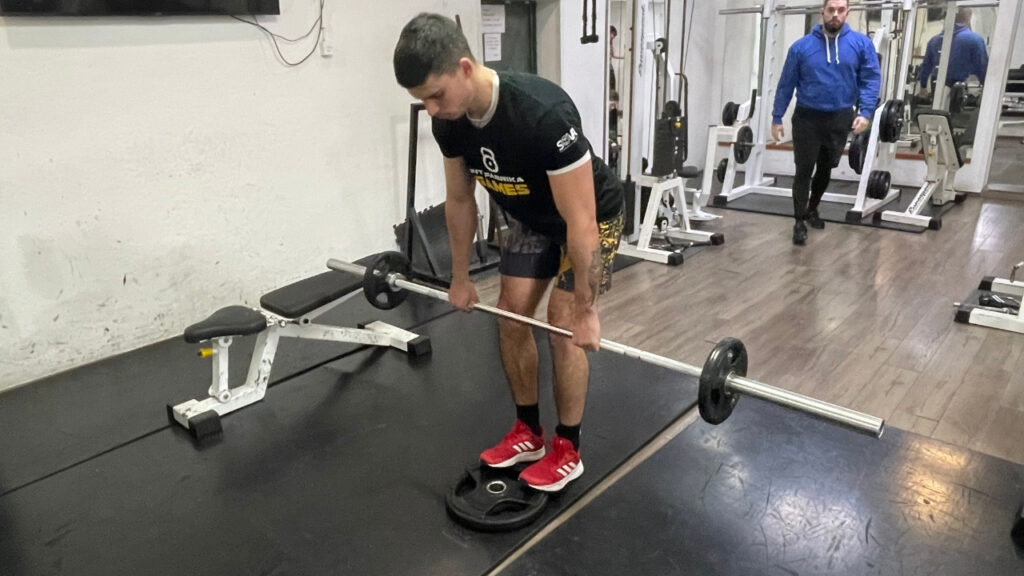
Pro Tip: Breathe in as you lower the barbell, and keep your head in a neutral position aligned with your spine to avoid neck strain.
Step Five — Perform the Ascending Phase
Reverse the movement by driving through your heels and hips to return to the starting position. Keep the barbell close to your body as you ascend.
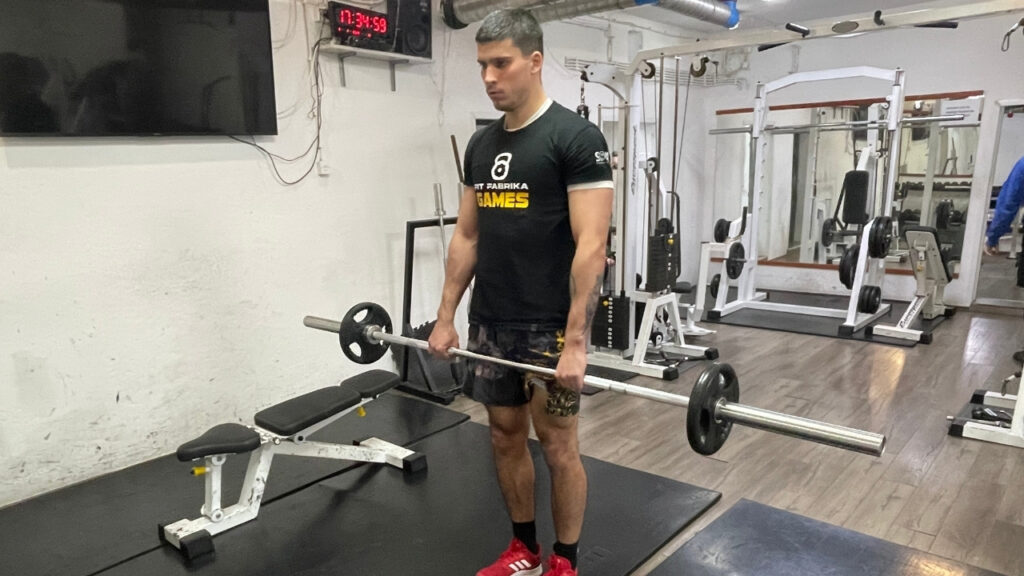
Pro Tip: Exhale as you lift, and squeeze your glutes at the top of the movement for maximum muscle engagement.
How to Program a Toes Elevated Romanian Deadlift
Programming a toes elevated Romanian deadlift (RDL) into a workout routine requires careful consideration of your fitness level and goals. This exercise primarily targets the hamstrings and glutes, with an emphasis on balance and posterior chain engagement.

Here is how to program a toes elevated Romanian deadlift:
- Frequency: Incorporate this exercise 1-2 times per week. In my experience, it’s very intense on the hamstrings, so adequate recovery time is essential.
- Sets and Reps: Start with 3-4 sets of 8-12 reps. Focus on form rather than weight, especially if you’re new to this variation.
- Progression: Begin with a lighter weight to master the movement. Gradually increase the weight as you become more comfortable, ensuring that your form remains correct.
- Position in Workout: Perform it at the beginning or in the middle of your workout. Since it’s a compound movement, it’s beneficial to do it when your muscles are fresh and already warmed up but not fatigued. Compound movements also require more central nervous system freshness, so performing them toward the beginning can be more beneficial.
- Combination with Other Exercises: Pair it with exercises that work for complementary muscle groups, like quadriceps-focused movements (e.g., squats or lunges), to ensure a balanced lower body workout.
A study from the PubMed website concluded that 8 weeks of resistance training emphasizing posterior chain muscles and core strengthening was effective in reducing anterior pelvic tilt (APT), improving vertical jump performance and hamstrings-to-quadricep (H:Q) ratio in healthy individuals [1].
Remember, quality over quantity. Prioritize proper form and controlled movements to maximize benefits and minimize the risk of injury.
Elevated RDL Muscles Worked
Here are the primary muscles working:
- Hamstrings (biceps femoris, semitendinosus, semimembranosus)
- Gluteus maximus
Also, here are the secondary muscles working:
- Erector spinae (spinalis, longissimus, iliocostalis)
- Core muscles (rectus abdominis, obliques, transverse abdominis)
- Upper back (trapezius, rhomboids, latissimus dorsi)
- Forearms (flexor and extensor muscle groups)
Elevated RDL Benefits
Here are the benefits of toes elevated RDLs.
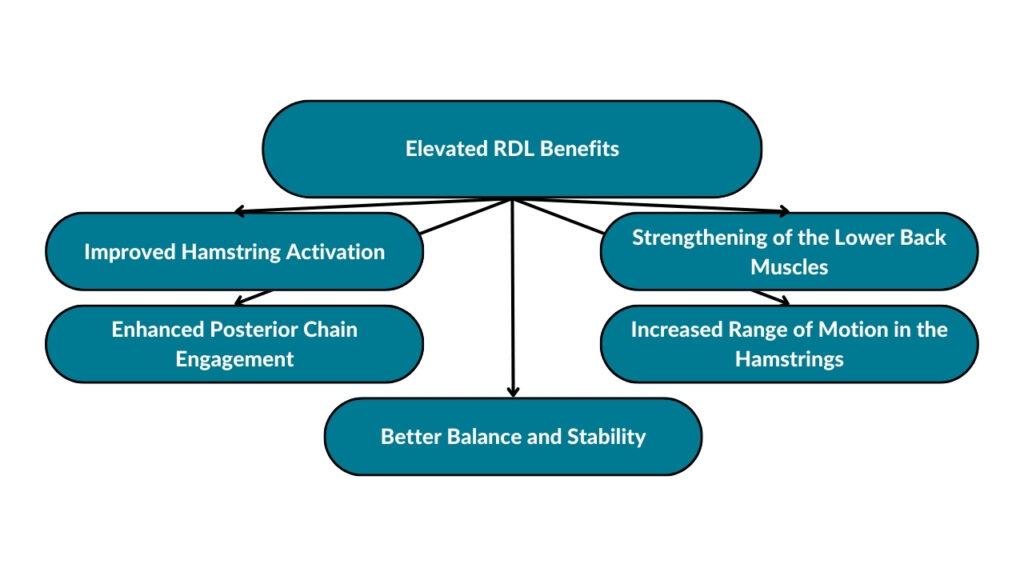
Improved Hamstring Activation
By elevating the toes, this variation of RDLs places greater emphasis on the hamstrings. In my experience, clients have reported a noticeable difference in hamstring engagement when performing this variation, leading to more effective strengthening and development of these crucial muscles.
Enhanced Posterior Chain Engagement
Elevated RDLs engage the entire posterior chain, which includes the hamstrings, glutes, and lower back. This comprehensive engagement is crucial for improving overall back strength, posture, and athletic performance.
Better Balance and Stability
Performing RDLs with toes elevated challenges your balance, requiring more stabilization from your core and lower body muscles. This not only improves your balance but also enhances proprioception, which is your body’s ability to sense its position and movement in space.
Increased Range of Motion in the Hamstrings
The elevation of the toes allows for a deeper stretch in the hamstrings at the bottom of the movement. This increased range of motion can lead to greater flexibility and mobility in the hamstrings.
From my experience, incorporating this exercise has helped clients achieve greater flexibility and mobility in their hamstrings, which is beneficial not just for athletic performance but also for everyday movements.
Strengthening of the Lower Back Muscles
The movement pattern of the elevated RDL effectively targets the lower back muscles, particularly the erector spinae. Strengthening these muscles is key for supporting the spine, reducing the risk of lower back pain, and enhancing core stability.
In a study of 408 participants across eight articles found on PubMed Central, posterior chain resistance training (PCRT) was found to be more effective than general exercise (GE) in reducing pain (SMD = -0.61), disability (SMD = -0.53), and increasing muscle strength (SMD = 0.67), especially over longer durations (12-16 weeks), with no significant difference in adverse events between the two methods [2].
The study also points out that patients with chronic lower back pain should consider utilizing posterior chain resistance training to reduce their pain and disability while improving their muscle strength.
What Are the Best Tips for Performing Toes Elevated Romanian Deadlifts?
Here are the best tips for performing toes elevated Romanian deadlifts.
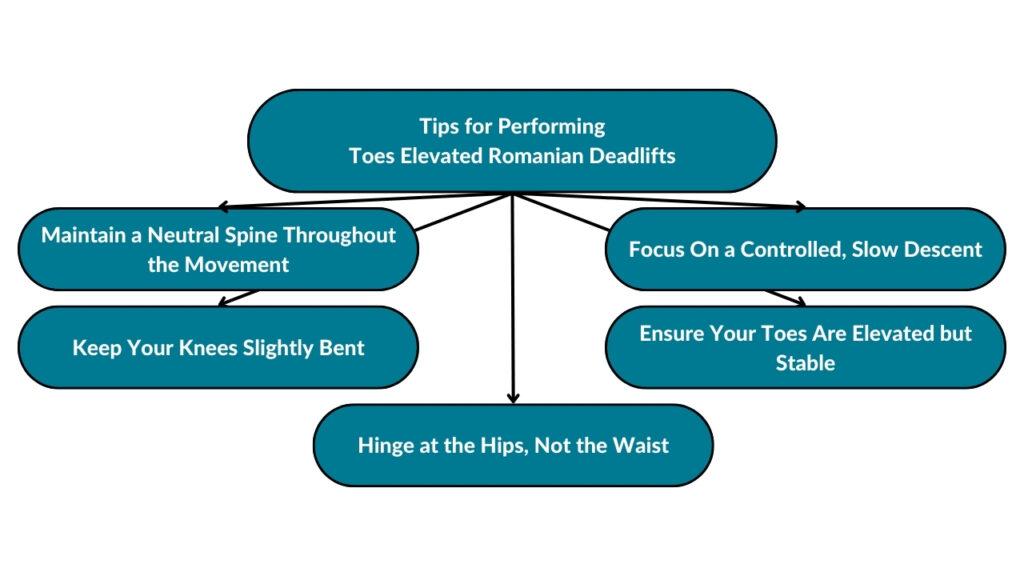
Maintain a Neutral Spine Throughout the Movement
It’s crucial to keep your spine in a neutral position during the entire exercise. This means avoiding rounding your back or overextending. A neutral spine protects your back and allows for optimal muscle engagement. I often remind clients to imagine keeping a straight line from their head to their tailbone.
Keep Your Knees Slightly Bent
While the focus is on hip movement, keeping a slight bend in the knees is important. This not only helps in activating the hamstrings and glutes more effectively but also reduces strain on the lower back. I’ve observed that a soft bend, rather than locking the knees, can make a significant difference in the effectiveness of the exercise.
Hinge at the Hips, Not the Waist
The movement should originate from your hips. Think of pushing your hips back rather than bending at the waist. This hip hinge is key for targeting the right muscles and maintaining proper form. I often guide clients by placing a hand on their lower back and another on their hips to teach them the correct hinging motion.
Ensure Your Toes Are Elevated but Stable
The elevation should be enough to increase hamstring engagement without compromising stability. Use a stable, flat object to elevate your toes. It’s important to ensure that the elevation is not too high, as I’ve seen this lead to balance issues and reduced effectiveness.
Focus On a Controlled, Slow Descent
The lowering phase of the lift is where a lot of the hamstring and glute work happens. I advise clients to count to three or four while lowering the weight, maintaining control and tension in the muscles throughout the descent. This controlled tempo increases muscle time under tension, enhancing strength and muscle growth.
What Are the Most Common Mistakes During Toes Elevated RDLs?
Here are the most common mistakes during toes elevated RDLs.
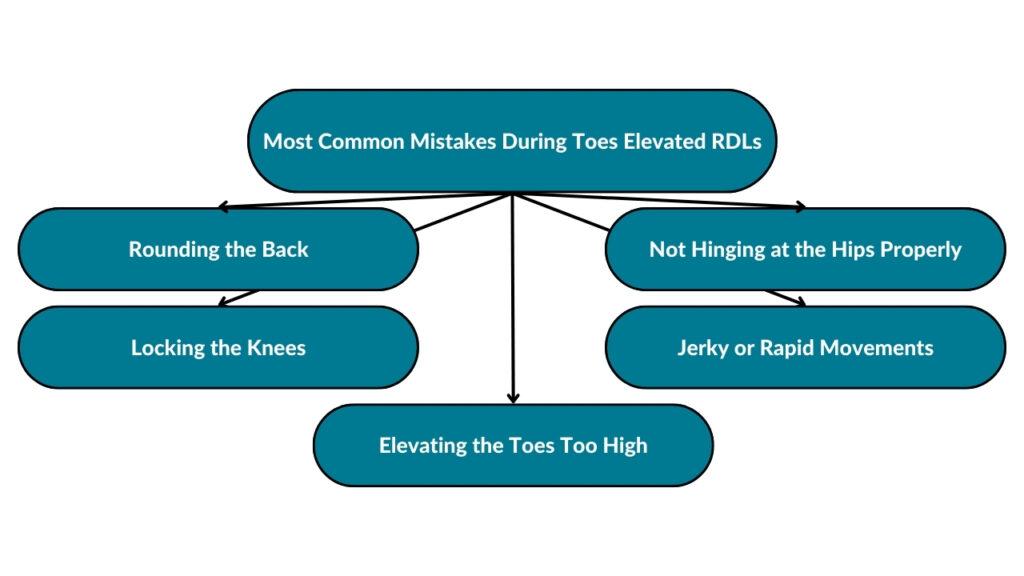
Rounding the Back
One of the most frequent mistakes is rounding the back during the lift. This improper form puts undue stress on the lower back and decreases the engagement of the target muscles (hamstrings and glutes).
It’s crucial to maintain a neutral spine throughout the movement. I often tell clients to focus on keeping their chest up and shoulders back to help maintain this alignment.
Locking the Knees
Fully locking out the knees can shift the strain away from the hamstrings and glutes and onto the knee joints. Instead, maintain a slight bend in the knees throughout the exercise. This slight bend allows for better muscle activation and reduces the risk of knee strain.
Elevating the Toes Too High
While toe elevation is key to this exercise, too much elevation can lead to balance issues and reduce the effectiveness of the movement. The elevation should be just enough to increase hamstring engagement without compromising stability or form.
Jerky or Rapid Movements
Performing the movement too quickly or with jerky motions can lead to loss of control and reduced muscle engagement. The focus should be on a controlled, smooth motion, especially during the descent. This controlled tempo ensures proper muscle activation and reduces the risk of injury.
Not Hinging at the Hips Properly
Incorrectly hinging at the waist instead of the hips is a common error. The movement should be a hip hinge, where the hips move backward while the spine remains neutral. This mistake often leads to improper muscle targeting and can strain the lower back. I often guide clients to practice the hip hinge without weight to get a feel for the correct movement pattern.
Are There Any Good Toes Elevated Romanian Deadlift Variations?
Below are some good toes elevated Romanian deadlift variations to consider.
Dumbbell Toes Elevated RDL
The dumbbell toes elevated RDL is a variation that uses dumbbells for added versatility and balance challenge. It’s excellent for those who prefer dumbbell training or have limited access to barbells.
Exercise instructions:
- Stand with your feet hip-width apart, toes on an elevated surface.
- Hold a dumbbell in each hand in front of your hips, palms facing your body.
- Hinge at your hips, pushing your buttocks back while keeping your back straight.
- Lower the dumbbells towards the floor, maintaining a slight bend in your knees.
- Go as low as your flexibility allows without rounding your back.
- Drive through your heels to return to the starting position, squeezing your glutes at the top.
Pro Tip: Focus on keeping the dumbbells close to your legs throughout the movement. This ensures better balance and targets the hamstrings and glutes more effectively.
Kettlebell Toes Elevated RDL
The kettlebell toes elevated RDL adds a unique grip and weight distribution challenge, making it a great alternative to traditional barbell or dumbbell RDLs.
Exercise instructions:
- Stand with your feet hip-width apart, toes on an elevated surface.
- Hold a kettlebell by the handle with both hands and arms extended.
- Hinge at your hips, push your buttocks back and keep your back straight.
- Lower the kettlebell between your legs, maintaining a slight bend in your knees.
- Descend as far as your flexibility allows without rounding your back.
- Drive through your heels to return to the starting position, engaging your glutes.
Pro Tip: Ensure a firm grip on the kettlebell to maintain control, especially during the descent. This helps in engaging the correct muscle groups and maintaining form.
Banded Toes Elevated RDL
he banded toes elevated RDL introduces resistance bands for a different tension profile, offering continuous resistance throughout the movement.
Exercise instructions:
- Stand with your feet hip-width apart, toes on an elevated surface.
- Place a resistance band under your feet and hold it with both hands at hip level.
- Hinge at your hips, push your buttocks back and keep your back straight.
- Lower your torso, maintaining a slight bend in your knees until you feel a stretch in your hamstrings.
- Drive through your heels to return to the starting position, engaging your glutes.
Pro Tip: Keep the tension on the band consistent; don’t let it slack at any point. This constant tension increases muscle activation for better strength gains.
Single-Leg Toes Elevated RDL
The single-leg toes elevated RDL, where one foot remains on the elevated surface while the other, the non-working leg, extends backward, is an advanced variation that challenges balance and unilateral strength, often making balance the limiting factor rather than load.
Exercise instructions:
- Stand on one leg with your toes on an elevated surface, the other leg slightly lifted behind you.
- Hold a dumbbell in the hand opposite to the standing leg.
- Hinge at your hips, extend your free leg behind you for balance and lower the dumbbell towards the floor.
- Keep your back straight and support your knee slightly bent.
- Lower as far as your balance and flexibility allow without rounding your back.
- Drive through the heel of your standing leg to return to the starting position.
Pro Tip: Focus on maintaining balance and control throughout the exercise. This variation not only strengthens the muscles but also improves core stability and balance.
Are There Any Good Toes Elevated Romanian Deadlift Alternatives?
Here are some good toes elevated Romanian deadlift alternatives to try.
Traditional Romanian Deadlifts
Traditional Romanian deadlifts are a fundamental strength exercise that targets the entire posterior chain, offering a balanced development of the back, glutes, and hamstrings.
Exercise instructions:
- Stand with your feet hip-width apart, holding a barbell in front of your thighs.
- Hinge at your hips, pushing your buttocks back while keeping your back straight and knees slightly bent.
- Lower the barbell towards the floor, keeping it close to your legs.
- Descend until you feel a stretch in your hamstrings, then drive through your heels to return to the starting position.
Pro Tip: Keep the barbell close to your body throughout the movement to reduce strain on your lower back. This also ensures maximum engagement of the hamstrings and glutes.
Single-Leg Romanian Deadlifts
Single-leg Romanian deadlifts focus on unilateral strength, improving balance and stability while effectively targeting each leg’s hamstrings and glutes.
Exercise instructions:
- Stand on one leg, holding a dumbbell in the opposite hand.
- Hinge at your hips, extend your free leg behind you for balance and lower the dumbbell towards the floor.
- Keep your back straight and support your knee slightly bent.
- Lower as far as your balance and flexibility allow, then drive through the heel of your standing leg to return to the starting position.
Pro Tip: Focus on a slow, controlled movement to maintain balance and maximize muscle engagement. This exercise not only strengthens the legs but also improves core stability.
Good Mornings
Good mornings is a classic exercise that primarily targets the lower back, hamstrings, and glutes, emphasizing hip hinge mechanics.
Exercise instructions:
- Stand with your feet hip-width apart, a barbell resting on your shoulders behind your neck.
- Hinge at your hips, pushing your buttocks back while keeping your back straight and knees slightly bent.
- Lower your torso until it’s parallel to the floor, then drive through your heels to return to the starting position.
Pro Tip: Start with a light weight to master the form and protect your lower back. This exercise is excellent for improving hip mobility and lower back strength.
Stiff-Legged Deadlifts
Stiff-legged deadlifts are a variation that places more emphasis on the hamstrings, with less bend in the knees compared to traditional RDLs.
Exercise instructions:
- Stand with your feet hip-width apart, holding a barbell in front of your thighs.
- Keeping your legs straighter than in a traditional RDL, hinge at your hips and lower the barbell towards the floor.
- Keep your back straight throughout the movement.
- Lower the barbell as far as your hamstring flexibility allows, then drive through your heels to return to the starting position.
Pro Tip: Keep the movement controlled, especially on the descent, to prevent lower back strain. This variation is excellent for isolating and strengthening the hamstrings.
Heels Elevated RDL
Heels elevated RDL shifts the focus slightly more towards the glutes and lower back, offering a different stimulus compared to the toes elevated version.
Exercise instructions:
- Stand with your heels on an elevated surface, holding a barbell in front of your thighs.
- Hinge at your hips, pushing your buttocks back while keeping your back straight and knees slightly bent.
- Lower the barbell towards the floor, keeping it close to your legs.
- Descend until you feel a stretch in your hamstrings, then drive through your heels to return to the starting position.
Pro Tip: The heel elevation changes the angle of the exercise, so start with a lighter weight to adjust to the new stimulus. This variation can help those with limited ankle mobility to achieve a deeper hip hinge.
Are Elevated RDLs for Glutes?
Yes, elevated Romanian deadlifts (RDLs) are effective for targeting the glutes. This exercise emphasizes hip extension, a key movement that engages the gluteus maximus.
When performing the lift, the elevation of the toes shifts the body’s center of gravity slightly, requiring the glutes to work harder to stabilize and extend the hips. This increased activation helps strengthen and tone the gluteal muscles.
Additionally, maintaining proper form during the exercise ensures maximum engagement of the glutes, making elevated RDLs a valuable addition to a glute-focused training regimen.
Are Elevated RDLs for Hamstrings?
Elevated Romanian deadlifts are particularly beneficial for the hamstrings. The elevation of the toes intensifies the stretch and engagement of the hamstring muscles during the exercise.
This position allows for a greater range of motion, which leads to more effective lengthening and strengthening of the hamstrings. The hamstrings play a crucial role in the movement, working to control the descent and power the ascent.
Therefore, Elevated RDLs are an excellent choice for anyone looking to enhance hamstring strength, flexibility, and overall development.
Heels or Toes Elevated RDL: Which Is Better?
Choosing between heels or toes elevated Romanian deadlifts (RDLs) depends on your specific training goals and physical needs.
Heels elevated RDLs shift the focus more toward the quadriceps and help those with limited ankle mobility to achieve a deeper hip hinge. This variation can be beneficial for individuals looking to balance their posterior and anterior chain strength.
On the other hand, toes elevated RDLs place greater emphasis on the hamstrings and glutes. The elevation of the toes intensifies the stretch and activation of these muscles, making it ideal for targeting the posterior chain. If your goal is to strengthen and develop the hamstrings and glutes specifically, toes elevated RDLs would be the better choice.
Ultimately, both variations have their unique benefits, and incorporating them into your routine can provide a comprehensive lower-body workout.
FAQs
Should RDLs Be Elevated?
RDLs should be elevated based on specific training goals and individual biomechanics. Elevating RDLs can alter the muscle focus and range of motion, making them more suitable for targeting certain muscle groups or accommodating mobility limitations.
What Is the Difference Between Heel Elevated and Toe Elevated RDL?
The difference between heel elevated and toe elevated RDL lies in the muscle emphasis and biomechanical demands. Heel elevated RDLs focus more on the quadriceps and aid in deeper hip hinging, while toe elevated RDLs emphasize the hamstrings and glutes, enhancing their stretch and activation.
What Type of RDL Is Best?
The best type of RDL depends on individual fitness goals and physical needs. Traditional RDLs are generally effective for overall posterior chain development, while variations like toe or heel elevated RDLs can be tailored to target specific muscle groups or address mobility issues.
Is RDL Safer Than Deadlift?
RDL is often considered safer than a traditional deadlift for individuals with lower back concerns. This is due to the RDL’s focus on hip hinge movement, which typically places less stress on the lower back compared to the deadlift’s full range from the floor.
What Type of RDL Is Best for Glutes?
The best type of RDL for glutes is typically the traditional or toe elevated RDL. These variations effectively engage the gluteal muscles through hip extension and increased hamstring stretch, making them ideal for gluteal development.
Wrapping Up
The toes elevated Romanian deadlift is an exceptional exercise for enhancing lower body strength, particularly in the hamstrings, glutes, and lower back. Its unique starting position, requiring more dorsiflexion at the ankles, not only provides a better initial stretch in the hamstrings but also maintains a fixed knee position, optimizing muscle engagement.
Whether you’re aiming to improve balance, increase hamstring flexibility, or strengthen your posterior chain, this exercise, when performed with proper form and technique, is a valuable addition to any fitness regimen.
Start Building Your Dream Body Today
Ready to elevate your fitness game without falling into the trap of dull, repetitive routines that just don’t deliver? Imagine sculpting your ideal physique and boosting your health, all while still enjoying life’s pleasures, like those irresistible weekend getaways and your aunt’s legendary cheesecake. With our online fitness and nutrition coaching service, you don’t have to compromise. Dive into a personalized fitness journey that blends perfectly with your lifestyle, not against it. Book your completely free discovery consultation today, and take the first step towards a transformation that doesn’t require giving up the joys of life.

“I was skeptical about online fitness coaching, but Functional Body Savage completely changed my perspective. Vanja and Radomir’s personalized approach and attention to detail have helped me achieve goals I never thought possible. I’m stronger, more confident, and grateful for their guidance.”
Emily Thompson, San Francisco, CA
Learn More About Our Online Coaching ServiceReferences:
- Leong CH, Forsythe C, Bohling Z. Posterior chain and core training improves pelvic posture, hamstrings-to-quadriceps ratio, and vertical jump performance. J Sports Med Phys Fitness. 2024;64(1):7-15. doi:10.23736/S0022-4707.23.15171-1
- Tataryn N, Simas V, Catterall T, Furness J, Keogh JWL. Posterior-Chain Resistance Training Compared to General Exercise and Walking Programmes for the Treatment of Chronic Low Back Pain in the General Population: A Systematic Review and Meta-Analysis. Sports Med Open. 2021;7(1):17. Published 2021 Mar 8. doi:10.1186/s40798-021-00306-w

